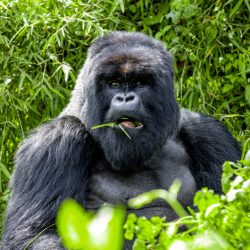Mountain gorillas in Bwindi, Uganda, and Sarambwe, DRC, to be counted in census
Blog | 30/08/11
A census of the critically-endangered mountain gorillas (Gorilla beringei beringei) in Bwindi Impenetrable National Park, Uganda, is scheduled to begin September 7, 2011. If security allows, this census will also include contiguous Sarambwe Nature Reserve, Democratic Republic of Congo.
The census is being conducted by the Uganda Wildlife Authority and the Institut Congolais pour la Conservation de la Nature with support from the Rwanda Development Board, local governments and partner organizations including the International Gorilla Conservation Programme (IGCP, a coalition of the African Wildlife Foundation, Fauna & Flora International, and the World Wide Fund for Nature), Max Planck Institute for Evolutionary Anthropology, Conservation Through Public Health, the Mountain Gorilla Veterinary Project, the Institute for Tropical Forest Conservation, and the Dian Fossey Gorilla Fund – International.
Six trained teams will systematically collect data within Bwindi Impenetrable National Park with an additional team dedicated to Sarambwe Nature Reserve. In a coordinated effort, teams will move from region to region searching for recent trails of mountain gorilla groups.
When a trail is found, teams will follow the trail for three consecutive nights, recording detailed data from their night nests. Mountain gorillas build an individual nest out of vegetation each night. It is the nests that will be recorded and counted, that data serving as a basis for scientific analysis of the population as a whole. This technique is referred to as the indirect sweep method.
Additional measures and analysis are in place to ensure as accurate a count as possible. Most notably, fecal samples will be collected from the nests for genetic analysis to ensure that under-counting or double-counting of individuals or groups does not occur. In addition, a team is already in Bwindi Impenetrable National Park doing a pre-census sweep. It is also worth noting that fecal samples will also be collected for a complete health screen of the entire population.
This is the second time genetic analysis will be used as a census tool with the Bwindi-Sarambwe population. Results from the last census in 2006 yielded 302 genetically-unique individuals, whereas the indirect sweep method yielded 336 individuals. In this case, it was determined that some of the gorillas were making more than one nest a night, and several groups and solitary males were counted more than once as different individuals. The genetic verification ensures that this potential double-counting does not occur during the analysis of the results.
As is now the practice, only the result incorporating the genetic analysis will be released as the most accurate estimate of the population. Because of this, we anticipate the results of this census will be released no sooner than nine months after the field census is complete.
“This census of mountain gorillas, like others IGCP has led in the past, is a truly collaborative effort. Staff from NGOs and government agencies throughout the region will be participating in this census, including a team from Kahuzi-Biega National Park in South Kivu Province in the Democratic Republic of Congo, outside of mountain gorilla territory,” said Maryke Gray, Technical Advisor for the International Gorilla Conservation Program and a lead coordinator of the 2011 Bwindi census.
In advance of this census, there are an estimated 786 mountain gorillas in the world, existing in and near transboundary protected areas in the Democratic Republic of Congo, Rwanda, and Uganda. While habituated groups of mountain gorillas, those accustomed to researchers and tourists, are monitored on a regular basis, the unhabituated gorillas are not. It is only through periodic scientific census that the entire population size can be estimated. A census of the Virunga Massif population of mountain gorillas in 2010 yielded 480 individuals along with four orphaned mountain gorillas in a sanctuary outside Virunga National Park.
Funding for the census is coming from the World Wide Fund for Nature-Sweden via the International Gorilla Conservation Programme with supplemental support coming from Berggorilla & Regenwald Direkthilfe e.V. and the Wildlife Conservation Society.
Photo credit: Maryke Gray/IGCP


